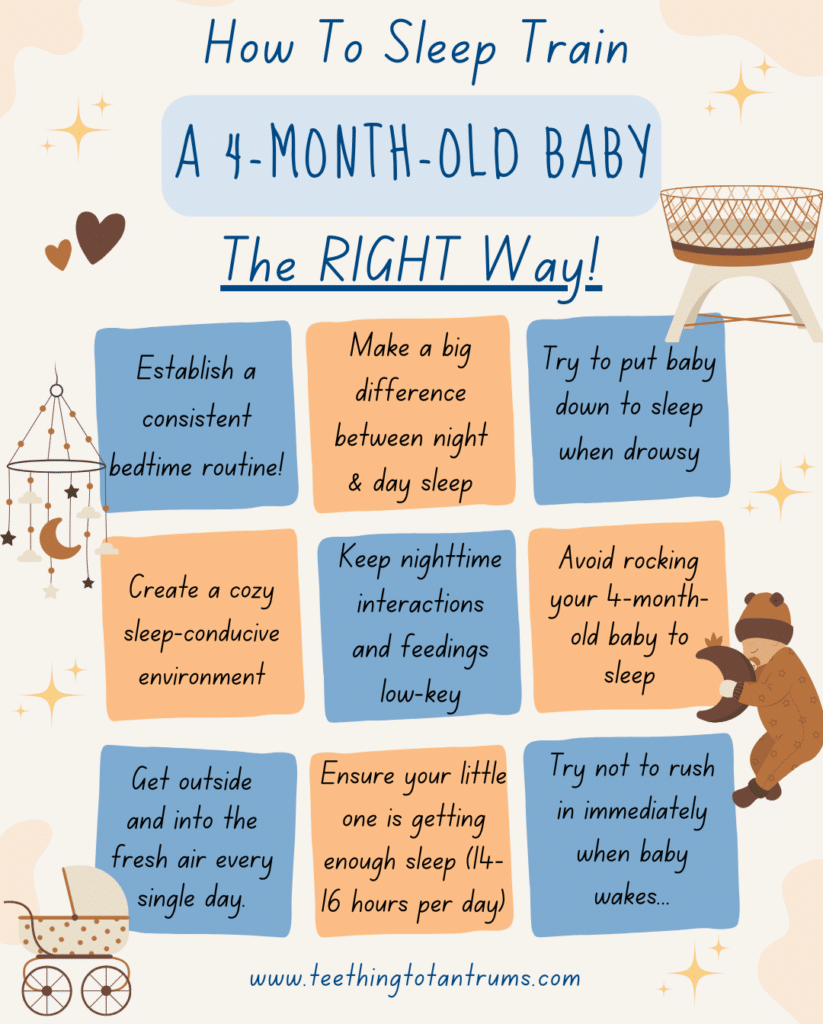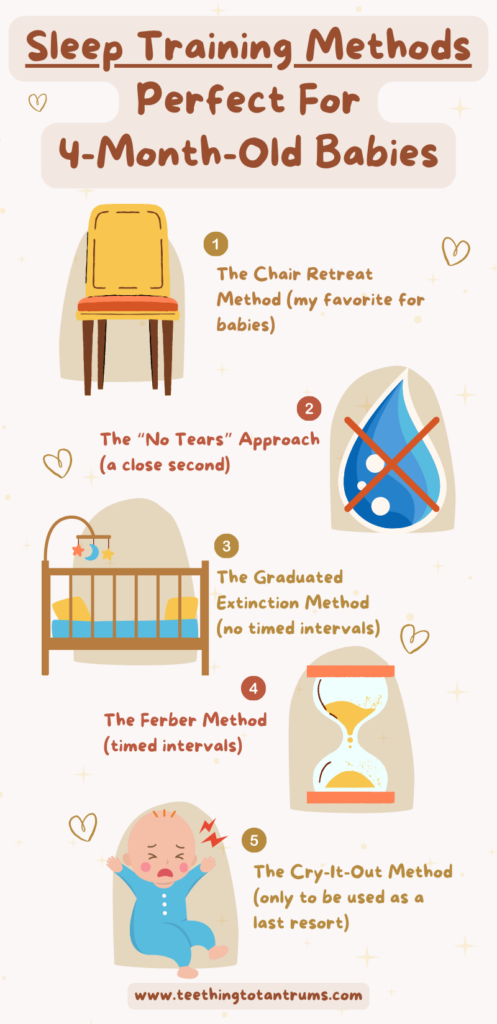Sleep training 4-month-old babies involves teaching your little one healthy sleep habits that will help them fall asleep on their own and stay asleep throughout the night for years to come.
But there’s more to sleep training a 4-month-old than meets the eye…
After 40 years as a Norland Nanny specializing in sleep issues, I’m here to share all I know about sleep training babies so you are guaranteed success with your little one.
So, without further ado, let’s get into it.

Table of Contents
What Is Sleep Training?
Sleep training is the art of teaching your baby to self-soothe, fall asleep independently, and create and maintain healthy sleep habits as they grow.
When Can You Start Sleep Training A Baby?
The AAP recommends that you start sleep training when your baby is at least 4 to 6 months old.
This is because at this age, babies can begin to develop a regular sleep-wake cycle and some can start to drop night feedings.
However, not every baby will be ready to sleep train so early on in their development. Keep ready to learn whether sleep training is suitable for your 4-month-old baby.
Is Sleep Training Safe For A 4-Month-Old?
Technically, yes, you can safely sleep train a 4-month-old baby.
However, it’s important to know that a lot is going on developmentally at 4 months old and this can have a big impact on your baby’s sleep.
Therefore, although it is possible and safe to sleep train a 4-month-old… you must remember that success and consistent sleep may be erratic and slow to establish.
You must also maintain safe sleep practices (sleeping on their back in a well-ventilated area) to reduce the risk of SIDS (sudden infant death syndrome) for sleep training to remain safe for your baby.
Looking to get your little one to sleep quickly and effortlessly? Check out my Bedtime and Nap Cheat Sheet and master the art of making daytime naps and bedtimes as seamless as possible.
A bedtime & nap cheat sheet so good your little one will ask you to put them to bed...
Laura Williams "This is a life saver! I'm so glad I downloaded your bedtime & nap cheat sheet. My little one actually asked me to put him to bed last night! Unbelievable! Thank you so much!"
Click Here For The FREE Cheat Sheet
How To Prepare 4-Month-Olds For Sleep Training
Remember, sleep training at 4 months old is all about preparing your little one for sleeping through the night and teaching them to self-soothe.
However, your baby’s health and emotional well-being should always be your priority.
Before you embark on implementing a sleep training method, I always advise putting an essential list of things in place that may make conventional sleep training unnecessary.
These healthy sleep habits include:

- Start to establish a recognizable and consistent bedtime routine that includes a warm bath, and baby massage, followed by calming activities like reading or singing lullabies. Also, ensure you get the bedtime timing right as an overtired baby has a harder time falling asleep and staying asleep. Consider a bedtime between 6 to 8 PM.
- Make a marked difference between daytime and nighttime sleep.
- Put baby down to sleep while drowsy but not fast asleep.
- Create a sleep-conducive environment in your baby’s room that is dimly lit and at the correct temperature. Use a white noise machine to prevent ambient noise from disturbing your little one especially if they are sleeping in the same room as you.
- Keep nighttime interactions and feedings low-key with little to no talking and no bright lights. Consider using a nightlight to help keep the sleep environment consistent.
- If your little one has been fed and changed, try and settle your baby back to sleep in their crib without rocking them to sleep in your arms.
- Get outside in the fresh air and natural light every day to balance your baby’s circadian rhythm and melatonin levels and promote healthy sleep.
- Ensure your little one is getting enough age-appropriate daytime sleep to avoid overtiredness which can disrupt the entire sleep schedule. Keep an eye on your baby’s wake window, the period they’re awake between naps too… For a 4-month-old, this is typically around 1.5 to 2 hours. Read my post on the 4-month sleep schedule to learn what to expect.
- Don’t rush in every time your baby wakes. A little fussing is normal and they may re-settle on their own. TOP TIP: Let your baby practice being awake and alone in the crib by placing your baby in their crib without the pressure of going to sleep. Use a mobile for entertainment and leave them for a short while to get used to entertaining themselves.
Remember, it’s crucial to consider your baby’s unique needs. While some 4-month-olds may respond well to these different sleep training methods, others may need a bit more time to learn to sleep independently.
And that’s completely fine!
If you’re already implementing the above 9 tips and your baby is still struggling to establish healthy sleep habits… It might be time to consider formal sleep training to help get their sleep on track.
Suitable Sleep Training Methods For A 4-Month-Old
At four months old, babies can be sleep-trained with gentle methods with great effectiveness. Here are my preferred sleep training methods for 4-month-old babies:

1. The Chair Method
The Chair Method is another one of my preferred methods for sleep training 4-month-old babies. It is very gentle and involves settling your baby when they’re drowsy but not asleep and sitting in a chair next to their crib.
If your baby starts to cry, reassure them with words, gentle shhussing, or a pat on the tummy, but do not pick them up. You then stay next to your baby until they fall asleep.
Over several nights, you move the chair further away until you’re eventually out of the room. Remember, always use your voice to soothe rather than pick your baby up.
2. The “No Tears” Approach
Also known as the “Pick Up, Put Down” method, the No Tears Approach involves putting your baby down when drowsy but not fast asleep, leaving them for a short while, and if your baby fusses you pick your baby up until they are calm then put them down again.
You repeat this method until your baby manages to fall asleep without being held.
This method can be very tiring for parents, but some have had great success with it. Give it a try if your baby needs a lot of physical reassurance to settle.
3. The Gradual Extinction Method
With the Graduated Extinction method, you let your little one cry or protest for progressively longer intervals that feel right before checking in on your baby.
The idea behind this method is that your baby will eventually get the message that they have to fall asleep without you.
This is not quite as harsh as the cry-it-out method as you do occasionally return to your little one when your gut tells you… but if all else has failed, the Graduated Extinction method might be a softer approach for you to try before going down the full cry-it-out route.
If your baby doesn’t sleep after 30 minutes, remove them from the bed and try again in 15 minutes.
This method takes time and patience but can work well for 4-month-olds.
4. The Ferber Method
The Ferber Method is a very well-known sleep training technique that involves gradually increasing the amount of time you leave your baby alone in their crib before going in to comfort them.
The goal is to teach your baby to self-soothe and fall asleep on their own by going in to check on them at extended intervals over the training period.
This method does involve leaving your baby to cry for short periods… so it may not suit everyone. For this reason, I would approach the Ferber method with caution for 4-month-old babies.
5. The Cry-It-Out Method
The Cry-It-Out Method involves leaving your baby to cry themselves to sleep. The idea is that your baby will learn to self-soothe and fall asleep on their own.
I only recommend the cry-it-out method as a last resort when all of my sleep training tips and alternative methods have failed to help baby sleep independently.
This is because the Cry-It-Out Method can be difficult for parents to implement.
While medically, leaving your baby to cry does not cause any long-term emotional damage, I personally feel that a 4-month-old baby should not be left to cry for long periods and most parents will struggle to do so.
Finally, I must say that you should not embark on any sleep training method if it does not feel right for you.
Many parents put off conventional sleep training of any kind until at least 6 months of age but if you want to give your little one the best chance to learn to self-settle and start their journey to independent sleep starting to implement my list of essential gentle sleep training guidelines will definitely help.
How Long Does It Take To Sleep Train A 4-Month-Old?
Sleep training at 4 months old does not have a set time frame as you may experience periods of success followed by periods of your little one waking more at night or struggling to settle.
This is because your baby is growing a lot at this age and their hunger can quickly escalate as they approach weaning. This can result in more night wakings.
In addition, as your little one becomes more aware they will quite naturally not want you to leave them.
Sleep regressions are also common at this age and can disrupt your best-laid sleep training plans.
That all being said… it typically takes 3 to 21 days for a 4-month-old to adapt to a sleep training method.
TOP TIP: Night weaning can be included in your sleep training plans too, as many 4-month-olds can sleep through the night without feedings. However, you should seek advice from your pediatrician if your 4-month-old suddenly starts waking more at night and appears to be very hungry as they may advise introducing some solids and give you general advice on how to night wean successfully.
Sleep Training For Naps With A 4-Month-Old
For your 4-month-old to be able to learn to fall asleep independently you will also need to address nap time settling.
Infant naps are crucial for your baby’s growth and mood regulation and many 4-month-olds will show signs of settling into a regular nap schedule.
When you see a nap pattern emerging, then it is an ideal time to introduce a consistent pre-nap routine (like a mini bedtime routine) with calming activities, cuddles, dimmed lights, and a lullaby.
You must also start putting baby down to nap in a consistent, cozy sleep space preferably with minimal light and noise.
Finally, if your little one shows signs of sleepiness BEFORE their scheduled nap time… be flexible and put them down for a nap.
Trying to keep a 4-month-old awake to reach the correct nap time will only end in a fussy baby that will struggle to settle due to overtiredness.
Two to three naps per day, lasting between one to two hours is ideal for 4 month olds.
NOTE: Even if your 4-month-old is still sleeping in your bedroom at night, you can let them nap in their crib in another room away from the hustle and bustle of the household. Bear in mind that it’s normal if your baby takes shorter naps during this learning phase.
Baby Sleep Training Books I Recommend
When initiating sleep training for your 4-month-old, it is helpful to be well-informed about the topic… Which is where sleep training books come in.
After 40 years as a Norland Nanny who’s read countless books and sleep-trained many children, these are the books I would suggest you read.
However, they come with one condition… Your little one is a unique individual and you need to adapt what you learn to suit your baby’s individual needs. You must follow the advice that feels right for you and your baby and don’t embark upon a common sleep training method just because it is ‘supposed’ to work quickly.
With that in mind, here are my top baby sleep training books:
1. The No-Cry Sleep Solution by Elizabeth Pantley
The No Cry Sleep Solution provides strategies that steer clear of letting your baby cry it out. Instead, it offers gentler alternatives to help your baby sleep through the night. It’s particularly favored by parents of 0-5 year olds seeking a softer sleep training method.
Gently guiding your toddler to better sleep becomes less of a battle with this book. The No-Cry Sleep Solution aims to provide you with researched, kind methods that respect your child's needs.
Implementing the tips provided feels relevant and doable, as each chapter follows through with advice matched to common situations.
What's truly beneficial is the understanding of sleep you gain. It's a relief to have your experiences validated and then addressed, flipping the script on bedtime struggles.
You're not just reading; you're learning and applying new strategies each night.
- Endorsed by many parents over the last 18 years for its effectiveness
- Focused on gentle techniques
- Includes valuable research insights
- Offers specific advice for 1-5 year olds
- Follows a gentle child-centred approach
- Covers a variety of bedtime issues such as night wakings and getting your toddler to stay in bed
- May not work for every child
- Some information might overlap with books you've previously read
- The solutions require patience and time
2. Healthy Sleep Habits, Happy Child by Dr. Marc Weissbluth
Healthy Sleep Habits, Happy Child is a staple for parents who value a research-backed approach to sleep training. It’s praised for its insights on attuning to your baby’s sleep cues and fostering lasting sleep patterns.
Focused on the Ferber Method of sleep training, however… it might not work for every young family.
In this brilliant book, backed by decades of research and case studies, Dr. Weissbluth presents the Ferber method, a gentle form of sleep training that involves teaching babies to fall asleep independently with check-ins.
Charts and routines cover naps, nighttime sleep, and adjusting schedules. The book also addresses common issues like bedsharing, co-sleeping, night wakings, and daytime sleepiness giving you an all-inclusive sleep training approach!
- Provides individualized plans based on baby's exact age
- Evidence-based and developmentally appropriate
- Addresses a wide variety of common sleep questions
- Offers flexibility within routines based on baby's temperament and needs
- Teaches independent sleep skills
- Requires consistency to see full effects
- Focuses heavily on rigid routines and schedules
- May be overwhelming amount of information for some
- The adaption of the Ferber Method can be difficult for some babies to handle
Can You Sleep Train During The 4 Month Sleep Regression?
Yes, you can sleep training during the 4-month sleep regression.
At 4 months old, your baby may very well experience a sleep regression which is characterized by more frequent awakenings and possibly increased fussiness.
This doesn’t mean you need to put sleep training on hold, but you must adjust your approach.
Consistency is always key when it comes to sleep, especially when your baby is going through sleep disruptions.
To navigate the 4-month sleep regression with your sleep training effort intact, consider the following:
- Stick to a calming regular bedtime routine to signal that it’s time to rest.
- Be flexible with feeding as 4-month-olds are often experiencing a growth spurt and may be extra hungry. This can promote more nighttime wakings.
- Try introducing a dream feed to help baby sleep for longer at night.
- Continue to put baby down drowsy but not fast asleep and always act on sleep cues quickly.
- Try to avoid overtiredness by making up for bad nighttime sleep with extra daytime naps. Remember to keep an eye on the amount of sleep your baby is getting in 24 hours. 4-month-old babies need 14-15 hours of sleep per day, split between 10 – 11 hours of sleep at night and 3.5 – 4.5 hours of day sleep (split across 3 to 4 naps).
TOP TIP: Don’t dash to your baby’s side when they wake up. Sometimes leaving your little one to fuss for a short time can result in them falling back into a deep sleep without you having to go to them. However, if they start to become distressed, you should go and soothe them.
When To Seek Medical Advice
During sleep training, you might question what’s normal and what’s not. Whilst most sleep disruptions are nothing to worry about, signs that require medical advice include:
- Excessive fussiness or crying which doesn’t improve with typical sleep training techniques.
- Increased need for feeds but baby is not gaining or losing weight.
- Persistent waking up at night coupled with signs of distress or discomfort.
- Your baby exhibits extreme irritability or sleepiness during the day.
Your pediatrician can provide guidance or refer you to a pediatric sleep doctor if needed as these symptoms may indicate an underlying condition that a professional should evaluate.
Remember, your instincts are important. If something feels off, it’s always best to seek advice.
TOP TIP: Keeping a sleep diary to share with your pediatrician can give them valuable information and help them understand your baby’s sleep patterns and identify any concerns. It can also help you ensure baby is getting enough sleep.
With one spacious page dedicated to each day, you'll have plenty of room in this delightful planner to write down all your to-dos, appointments, and notes for the year.
Ideal for parents tracking baby's sleep, feeding, and pooping schedules...
Or a sleep journal for toddlers...
Whatever your requirements for the diary need to be, this handy planner will tick the right boxes.
Frequently Asked Questions About Sleep Training 4-Month-Old Babies
Navigating sleep training for your 4-month-old can raise many questions. This section aims to answer some of the most common queries.
Q: What methods are effective for sleep training a breastfed 4-month-old?
A: No matter how your baby is fed for this age, I would consider a gentle approach to sleep training your 4 month old. Methods like The Chair Method or The No Tears Approach. You also need to ensure your baby is fully fed before starting the sleep training routine at night.
Q: How can a consistent sleep schedule contribute to sleep training for a 4-month-old baby?
A: A consistent sleep schedule helps your baby to set their internal clock. It makes it easier for them to predict and adapt to sleep times. Remember that sticking to a regular nap and bedtime hour is key for effective sleep training.
Q: What are appropriate naptime routines for a 4-month-old undergoing sleep training?
A: Your 4-month-old’s naptime routine should be calming and predictable. You could include activities such as reading a short book or playing soft music. This routine signals to your baby that it’s time to wind down for a nap.
Q: What are the pros and cons of using ‘cry it out’ as a sleep training method for a 4-month-old?
A: In some cases, the ‘cry it out’ method can teach self-soothing more quickly. Yet, it might be stressful for both you and your baby and can be quite controversial. It is not my favored method for this age group and you need to think carefully about the emotional impact on you and your baby before choosing this method.
Q: How can I gently encourage my 4-month-old to fall asleep independently?
A: To gently encourage your 4-month-old to fall asleep independently, start by creating a soothing pre-sleep routine that doesn’t involve feeding or rocking to sleep. Lay your baby down drowsy but awake to help them learn to fall asleep on their own. Offer comfort with your presence without picking them up.
Q: What are some sleep training strategies for a 4-month-old to help them sleep through the night?
A: To help your baby sleep through the night, ensure they’re getting enough sleep during the day to avoid overtiredness and enough to eat to fuel their rapid development (your baby needs about 25 ounces of breast milk per day). Consider introducing a dream feed to prevent too many nighttime wakings for food and keep daytime feeds active and evening feeds calm to help baby learn the difference between day and night.
Q: Is 4 months too early for Ferber Method?
A: No, technically 4 months old is not too early to try the Ferber Method. However, it can be daunting for some parents to hear their children cry when falling asleep… So consider using a gentler sleep training method such as The Chair or No Tears Approach first.
Q: How long should you let a 4 month old cry it out?
A: There is no time limit on the Cry-It-Out Method. You simply put baby down to bed and leave them until they fall asleep. If you use this method, be prepared for your baby to cry anywhere from 10-60 minutes.
Need More Parenting Help?
- Download our FREE Bedtime & Nap Sleep Cheat Sheet. It’s a free, easy-to-use and proven formula designed for parents of 0-5 year olds to master the art of consistently undisturbed and restful sleep without the yelling, nagging or exhausting long-winded evenings.
- Check out our Parenting Toolbox. You’ll get access to expertly-chosen products that you can guarantee are the best for your little one and your wallet.
- Are you looking for personalized guidance to navigate the challenges of parenting? I offer 1-on-1 consultations to bring you tailored strategies and actionable advice to help support your child's growth and well-being with confidence.

A bedtime & nap cheat sheet so good your little one will ask you to put them to bed...
Laura Williams "This is a life saver! I'm so glad I downloaded your bedtime & nap cheat sheet. My little one actually asked me to put him to bed last night! Unbelievable! Thank you so much!"
Click Here For The FREE Cheat Sheet





